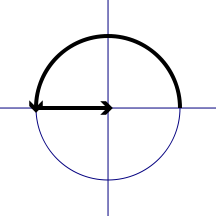| Revision as of 07:37, 18 November 2006 editTheSeven (talk | contribs)Extended confirmed users906 edits 0 and 1 are more than that; so I think it's better to leave them—even people with no math know them← Previous edit | Revision as of 16:07, 8 December 2006 edit undo195.113.27.243 (talk) link csNext edit → | ||
| Line 87: | Line 87: | ||
| ] | ] | ||
| ] | |||
| ] | ] | ||
| ] | ] | ||
Revision as of 16:07, 8 December 2006

- For other meanings, see List of topics named after Leonhard Euler
In mathematical analysis, Euler's identity, named after Leonhard Euler, is the equation
where
- is Euler's number, the base of the natural logarithm,
- is the imaginary unit, one of the two complex numbers whose square is negative one (the other is ), and
- is pi, the ratio of the circumference of a circle to its diameter.
Euler's identity is also sometimes called "Euler's equation".
Perceptions of the identity
Euler's identity is remarkable for its mathematical beauty. Three basic arithmetic functions are present exactly once: addition, multiplication, and exponentiation. As well, the identity links five fundamental mathematical constants:
- The number 0.
- The number 1.
- The number π, which is ubiquitous in trigonometry, Euclidean geometry, and mathematical analysis.
- The number e, the base of natural logarithms, which occurs widely in mathematical analysis.
- The number i, imaginary unit of the complex numbers, which contain the roots of all nonconstant polynomials and lead to deeper insight into many operators, such as integration.
Furthermore, in mathematical analysis, equations are commonly written with zero on one side.
A reader poll conducted by Physics World in 2004 named Euler's identity the "greatest equation ever", together with Maxwell's equations.
Constance Reid even claimed that Euler's identity was "the most famous formula in all mathematics".
Gauss is reported to have commented that if this formula was not immediately apparent to a student on being told it, the student would never be a first-class mathematician.
After proving the identity in a lecture, Benjamin Peirce, a noted nineteenth century mathematician and Harvard professor, said, "It is absolutely paradoxical; we cannot understand it, and we don't know what it means, but we have proved it, and therefore we know it must be the truth."
Derivation

The identity is a special case of Euler's formula from complex analysis, which states that
for any real number x. In particular, if
then
Since
and
it follows that
which gives the identity
Generalization
Euler's identity is a special case of the more general identity that the n-th roots of unity, for n > 1, add up to 0:
Euler's identity is retrieved from this generalization by putting n = 2.
Notes
- Crease, 2004.
- Reid, From Zero to Infinity.
- Derbyshire p.210.
- Maor p.160 and Kasner & Newman p.103–104.
References
- Crease, Robert P., "The greatest equations ever", PhysicsWeb, October 2004.
- Derbyshire, J. Prime Obsession: Bernhard Riemann and the Greatest Unsolved Problem in Mathematics (New York: Penguin, 2004).
- Kasner, E., and Newman, J., Mathematics and the Imagination (Bell and Sons, 1949).
- Maor, Eli, e: The Story of a number (Princeton University Press, 1998), ISBN 0-691-05854-7
- Reid, Constance, From Zero to Infinity (Mathematical Association of America, various editions).

 is
is  is the
is the  ), and
), and is
is 






